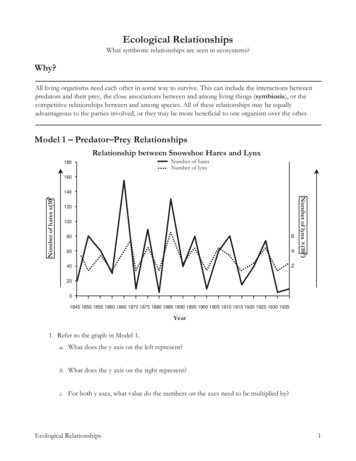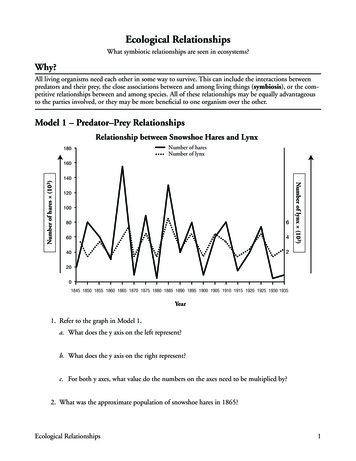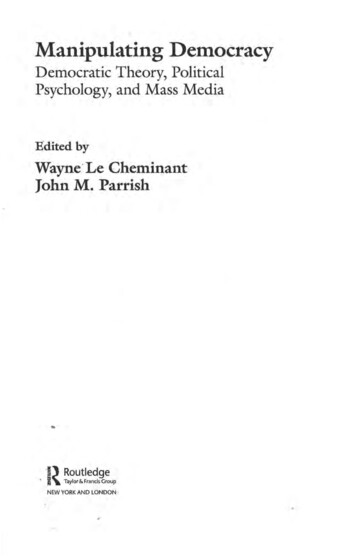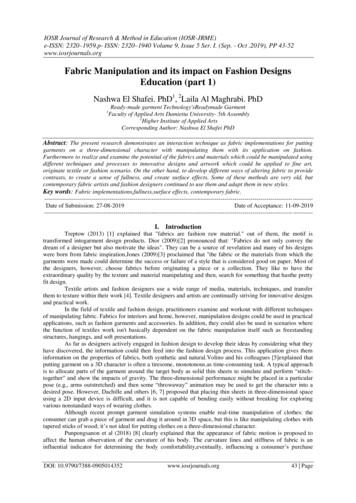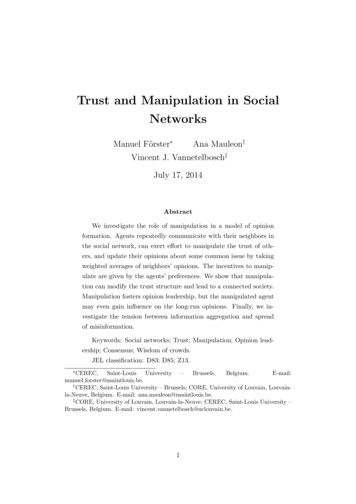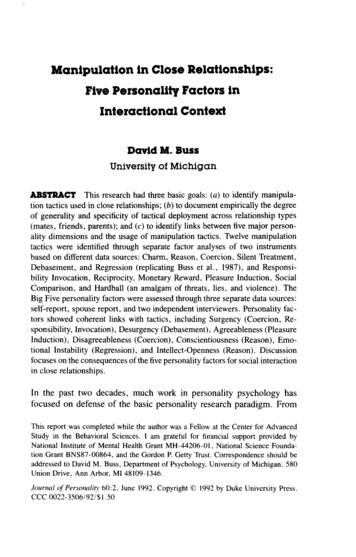
Transcription
Manipulation in Close Relationships:Five Personality Factors inInteractional ContextDavid M. BussUniversity of MichiganABSTRACT This research had three basic goals: (a) to identify manipulation tactics used in close relationships; (b) to document empirically the degreeof generality and specificity of tactical deployment across relationship types(mates, friends, parents); and (c) to identify links between five major personality dimensions and the usage of manipulation tactics. Twelve manipulationtactics were identified through separate factor analyses of two instrumentsbased on different data sources: Charm, Reason, Coercion, Silent Treatment,Debasement, and Regression (replicating Buss et al., 1987), and Responsibility Invocation, Reciprocity, Monetary Reward, Pleasure Induction, SocialComparison, and Hardball (an amalgam of threats, lies, and violence). TheBig Five personality factors were assessed through three separate data sources:self-report, spouse report, and two independent interviewers. Personality factors showed coherent links with tactics, including Surgency (Coercion, Responsibility, Invocation), Desurgency (Debasement), Agreeableness (PleasureInduction), Disagreeableness (Coercion), Conscientiousness (Reason), Emotional Instability (Regression), and Intellect-Openness (Reason). Discussionfocuses on the consequences of thefivepersonality factors for social interactionin close relationships.In the past two decades, much work in personality psychology hasfocused on defense of the basic personality research paradigm. FromThis report was completed while the author was a Fellow at the Center for AdvancedStudy in the Behavioral Sciences. I am grateful for financial support provided byNational Institute of Mental Health Grant MH-44206-01, National Science Foundation Grant BNS87-00864, and the Gordon P. Getty Trust. Correspondence should beaddressed to David M. Buss, Department of Psychology, University of Michigan, 580Union Drive, Ann Arbor, MI 48109-1346.Journal of Personality 60:2, June 1992. Copyright 1992 by Duke University Press.CCC 0022-3506/92/S 1.50
478Bussthis protracted period of self-scrutiny, three major conclusions haveemerged. First, there is considerable evidence that personality traitsshow moderate to strong stability over time (e.g. Buss, 1985; Conley,1984; Costa & McCrae, 1980). Second, behavior does show a great dealof context-specificity and discriminativeness (Cantor & Zirkel, 1990;Wright & Mischel, 1987). Third, at least five major dimensions appearto be necessary to describe the major ways in which individuals differwithin the personahty sphere (e.g., Digman & Inouye, 1986; Goldberg,1981; Hogan, 1983; John, Goldberg, & Angleitner, 1984; McCrae &Costa, 1985; Norman, 1963; Zuckerman, Kuhlman, & Camac, 1988).The five-factor model of personality (Surgency, Agreeableness, Conscientiousness, Emotional Stability, and Intellect-Openness) has gainedsupport from diverse investigators using different instruments, differentdata sources, and different populations (Digman & Inouye, 1986; Digman & Takemoto-Chock, 1981; Goldberg, 1981; Hogan, 1983; McCrae& Costa, 1985, 1987; Norman, 1963). One need not accept the viewthat this model is either comprehensive or adequate to recognize thatthese five dimensions have accrued enough independent replications toqualify as major dimensions of personality.The basic findings of temporal stability and the existence of at leastfive major personality factors suggest two important research agendasfor the field of personality psychology. The first involves identifyingthe causal origins of these individual differences. This task lies withinthe province of developmental personality psychologists (e.g., Daniels,1986), behavioral geneticists who study genetic and environmentalsources of individual differences (e.g., Plomin, DeFries, & McClearn,1980), psychologists focusing on the psychophysiology of personality(e.g., Eysenck, 1981; Humphreys &Revelle, 1984; Zuckerman, 1990),and evolutionary psychologists who focus on the adaptive origins ofindividual differences (e.g. Buss, 1991a). A second important task isto identify the consequences of major personality factors: What are theimplications of personality for the ways in which individuals interactwith their worlds? The present study represents a contribution to thissecond goal and deals with the consequences of five major dimensionsof personality for the ways in which individuals manipulate or infiuencepersons inhabiting their social environment.Manipulation represents one of three major components of a proposed interactional framework of personality (Buss, 1984,1985,1987).This framework has as its focus the interactional processes by whichindividuals are nonrandomly exposed to different environments. Selec-
Tactics of Manipulation479tion, the first mechanism, deals with nonrandom entry into, or avoidance of, certain environments. Evocation, the second mechanism, isdefined by the actions, strategies, upsets, confiicts, coercions, and reputations that are unintentionally elicited by individuals displaying certaincharacteristics. Manipulation, the third proposed class of mechanisms,is defined as the means by which individuals intentionally (althoughnot necessarily consciously) infiuence, alter, or shape those selectedenvironments (Buss, 1987).A first step in understanding manipulation is the taxonomic task—identifying, naming, and ordering the diverse tactics by which individuals infiuence and exploit the psychological mechanisms and behavioralmachinery of others. A step toward this goal has been made by Buss,Gomes, Higgins, and Lauterbach (1987). They identified six tactics ofmanipulation in the context of dating relationships: Charm, Silent Treatment, Coercion, Reason, Regression, and Debasement, These tacticsshowed individual difference consistency across the contexts of behavioral instigation (getting another to do something) and behavioral termination (getting another to stop doing something). The Charm tactic,however, was used more frequently for behavioral elicitation, whereasthe Coercion and Silent Treatment tactics were used more frequentlyfor behavioral termination.A major limitation of that study is apparent for achieving the taxonomic goal. Only a single relationship was used to identify and assesstactics of manipulation—that of intimate dating partners. The diversityof tactics used with others may be much greater than the six identified.Given the multiplicity of goals toward which tactics of manipulation aredirected, as well as the diverse relationships within which they occur,six tactics may drastically underrepresent the major manifestations ofmanipulation.A second step toward understanding manipulation, therefore, is toidentify the generality or specificity of tactical deployment across contexts. Although consistency of manipulation tactics was demonstratedacross the contexts of instigation and termination, another major contextual variable would be type of relationship. Are tactics of manipulation displayed consistently across relationships with spouses, mothers,fathers, and close friends? Or are different tactics targeted for thesedifferent relationships? Thus, one goal in this research program is tocontribute to identifying systematic sources of context specificity oftactical deployment.A third step in this research program is to identify the tactics of
480Bussmanipulation used by individuals who differ on each of five major dimensions of personality. The demonstration of coherent links betweenpersonality variables, traditionally assessed, and specific manipulationtactics would place personality in functional context. It would demonstrate that personality characteristics do not reside as static attributesof persons, but instead carry consequences for the ways in which individuals interact with their social worlds.Several diverse strands of research suggest promise for this direction. Thorne (1987), for example, found that extraverts adopt differentstrategies than introverts when interacting with others. Extraverts striveto establish common ground, while introverts adopt an interviewer'sstance, presumably to avoid too much talking or self-disclosure. Bussetal. (1987) found that those high on EPQ Neuroticism (Eysenck, 1981)tended to use Coercion and Silent Treatment tactics to infiuence theirintimate dating partners. Persons scoring high on the IAS Ambitiousscale (Wiggins, 1979) tended to use the Reason tactic. Those scoringrelatively high on IAS Lazy tended to use Debasement. Those high onIAS Calculating tended to deploy a wide variety of tactics, most notablyCharm, Silent Treatment, Reason, and Debasement,In sum, this research had three major goals: (a) to develop a morecomprehensive taxonomy of manipulation tactics by uncovering tacticsused within several close social relationships; (b) to document empirically the generality or specificity of tactical deployment across thesedifferent relationships; and (c) to place the five-factor model of personality in functional context by identifying links between each of themajor dimensions and usage of manipulation tactics within and acrossrelationships.Preliminary Study:Nominations of Acts of InfluenceSubjectsOne-hundred and thirty-two undergraduates participated in this phaseof the study. Subjects received experimental credit for a psychologyclass in return for their participation.ProcedureSubjects were requested to nominate acts of infiuence within differenttypes of close relationships: acts directed at close friends, mothers.
Tactics of Manipulation481and fathers, as well as acts performed by close friends, mothers, andfathers. The basic instructional set was as follows:We are interested in the things that people do to influence others inorder to get others to do what they want. Please think of your MOTHER[closest friend, father, etc.]. How do you get this person to do something? What do you do? Please write down specific behaviors or actsthat you perform in order to get your mother [closest friend, etc.] todo things. List as many different sorts of acts as you can.Each nomination was examined for its redundancy with the original set of 35 acts of infiuence (Buss et al., 1987) that were nominatedwithin the context of close intimate relationships. Redundant acts wereeliminated. All distinct acts were retained for the subsequent studies.These procedures resulted in the addition of 47 new and distinct actsof infiuence. These were added to the original set of 35 to generate an82-act instrument.Main StudyMETHODSubjectsSubjects for the main study were 214 individuals composing 107 rnarriedcouples. Couples were used in order to obtain two separate data sources forassessing each act of influence. Names of couples were obtained through thepublic court records of marriage licenses issued within a 6-month period.Couples were first contacted by letter. The ages of the husbands ranged from17 to 41, with a mean of 26.68 (SD 3.71). The wives ranged in age from 18to 36, with a mean of 25.54 {SD 4.05). Further details of the sample maybe obtained from Buss (1989).MaterialsAmong a larger battery of assessment instruments, the following measureswere used for this study.Self-reported tactics of manipulation. Four different instruments were administered in self-report form to assess manipulation tactics in four separate relationships—with the spouse, close friend, mother, and father. The generalinstructional set for each instrument was as follows:When you want to get your wife [husband, close friend, mother, father] todo something for you, what do you do? Look at each of the items listed
Bussbelow and rate how likely you are to do each when you are trying to getyour wife [husband, etc.[ to do something. None of them will apply to allsituations in which you want your wife [husband, etc.] to do something;simply rate how likely you are in general to do what is described. If youare extremely likely to do it, then circle a "7." If you are not at all likelyto do it, then circle a " 1 . " If you are somewhat likely to do it, then circlea "4." Give intermediate ratings for intermediate likelihoods of performingthe behaviors.Observer-reported tactics of manipulation. In a separate testing session, threedifferent instruments were administered (influence tactics used by one's spouse,one's mother, and one's father). The instructional set paralleled that of theself-reported tactics, with appropriate alterations with respect to nature of relationship and observer-based format. In this article, 1 am concerned with theobserver-reported tactics of the spouse, which can be used as an alternative toself-reports. Thus, for each subject, we know not only how he or she claimsto manipulate the other, but also how the other perceives she or he is beingmanipulated.Self-reported personality characteristics. A 40-item personality instrument wasadministered along with the other self-report instruments. This consisted ofbipolar adjective scales, eight each for Surgency (e.g., bold-timid), Agreeableness (selfless-selfish). Conscientiousness (reliable-undependable). EmotionalStability (secure-insecure), and Intellectance-Openness (intelligent-stupid).The instrument is based on factor analyses reported by Goldberg (1983).Spouse-observer reporting of personality characteristics. A parallel version ofthe Goldberg (1983) instrument described above was administered in a separatetesting session to the spouses of each subject.Interviewer-based observer reporting of personality characteristics. Eachcouple was interviewed by a pair of trained interviewers drawn from a 10member team. Each interview lasted approximately 40 minutes. A set of standard questions were posed to each couple, including: How did you meet? Whatare the similarities and differences between you? What are the sources of conflict in your marriage? Were your parents for or against the marriage? How doyou make joint decisions? In addition to these standard questions, interviewers were trained to probe further into issues raised during the course of theinterview.Directly following each interview, the two interviewers independently ratedeach subject on a parallel version of the Goldberg (1983) 40-item instrument. Subsequently, the interviewer ratings were standardized and compositedwith unit weighting to form five scores for each subject for Surgency, Agree-
Tactics of Manipulation483ableness. Conscientiousness, Emotional Stability, and Intellectance-Openness.Thus, personality characteristics were assessed through three separate datasources—self-report, spouse report, and interviewer report.ProcedureSubjects participated in three separate episodes of assessment. First, they received through the mail a battery of instruments to be completed in their homeduring their spare time. This battery contained most of the self-report instruments. Second, subjects came to a laboratory testing session to complete a battery of procedures, most of which pertained to reports about their spouse (e.g.,spouse's tactics of manipulation). Spouses were separated for the duration ofthe testing session to preserve independence of responses. Third, couples wereinterviewed as a couple to provide information about the relationship and exposure to the interviewers, who in turn provided personality descriptions. Totalconfidentiality of all responses was assured for subjects. Not even the subject'sspouse could see the responses without written permission.RESULTSFactor Analyses of Manipulation TacticsBecause previous studies have revealed a "general" factor in act reportdata that may be partially due to a response set (Botwin & Buss, 1989),the data were ipsatized prior to factor analyses. Two sets of factor analyses were conducted on the ipsatized scores, using varimax rotation, toidentify the major dimensions along which tactics of manipulation vary.One set was conducted on the self-reported tactics used to infiuenceone's spouse, and a second set on spouse-observer-reported tactics.These two data sources were used as primary because they contain thebest ratios of subjects to reported acts (approximately 3 to 1), whereasdata on the other instruments had ratios of only half that size.Twelve clear factors emerged across these two data sources. Theseare shown in Table 1, along with the factor loadings of those items thatconsistently loaded on the same factor across the two data sources. Sixfactors replicate those found by Buss et al. (1987): Coercion, Regression, Debasement, Charm, Reason, and Silent Treatment.Six new factors emerged across data sources that were not discoveredby the earlier study. Responsibility Invocation contains acts that involveinvoking commitment, responsibility, and disappointment upon failureto perform the act. The Reciprocity-Reward tactic contains acts that
484BussTable 1Factor Loadings for Manipulation nDemand that she do itCriticize her for not doing itYell at her so she'll do it.58.75.43.75.58.74Responsibility InvocationGet her to make a commitment to doing itGive her a deadline to do it.76.70.77.64Pout until she does itSulk until she does itWhine until she does it.77.79.55.68.50.76Reciprocity-RewardTell her I'll do her a favor if she'll do itDo something in exchange so that she will do itPromise her that next time I will do what she wantsGive up something so she'll do it.77.77.43.33.78.78.35.38DebasementLower myself so she'll do itAllow myself to be debased so she'll do itLook sickly so she'll do onHardballHit her so she will do itTell her you'll leave her if she doesn't do itImply the possibility of physical harmif she doesn't do itLie so that she will do itDegrade her into doing itUse deception to get her to do itDo something violent so she will do itAsk her to do itWithhold money until she does itThreaten to cut off her money if shedoesn't do it
Tactics of Manipulation485Table 76.73.66.70.39.56.71,73.33Silent TreatmentIgnore her until she agrees to do itBe silent until she agrees to do itDon't respond to her until she does it.66.76.76.70.74.76Pleasure InductionTell her that she will enjoy itShow her how much fun it .67.28Factors/actsCharmCompliment her so she'll do itAct charming so she'll do itReasonExplain why you want her to do itGive her reasons for doing itPoint out all the good things that willcome from doing itSocial ComparisonCompare her to someone who would do itTell her that other partners would do itTell her that everyone is doing itTell her that she will look stupid ifshe doesn't do itMonetary RewardPromise to buy her something if she does itGive her a small gift or card before askingher to do itOffer her money so she will do itinvolve exchange, favors, and promises of future return. The Hardballtactic contains threats of withholding money, physical violence, anddeception.Pleasure Induction involves convincing the other that the act will befun or enjoyable, as well as in their best interest to perform. SocialComparison contains acts that involve comparing the spouse to others
486Busswho would perform the act, mentioning that everyone else is doing it,and appealing to social opprobrium that would ensue if the act is notperformed. Monetary Reward involves payment of money or gifts contingent on the act being performed. These 12 factors represent a majorexpansion of the taxonomic work started by Buss et al. (1987) that uncovered six tactics of manipulation. These factors were carried forwardin subsequent analyses.Reliabilities of Tactic CompositesAlpha reliability coefficients were computed for each of the compositesfor each of the seven conditions and data sources. These ranged from.49 to .85, with a mean of .66 for the self-report data on infiuence tactics; and from .60 to .86, with a mean of .68 for the spouse-reportedinfluence tactics. The reliabilities for the other contexts were generallyslightly lower, with means of .57 for friends, .62 for mothers, and .63for fathers.Sex Differences in Deployment ofManipulation TacticsBuss et al. (1987) reported few sex differences in tactics of manipulation, and no sex differences appeared to exist across data sourcesand conditions of instigation and termination. To examine sex differences in this study, t tests were conducted for each tactic for each ofthe seven conditions and data sources. Within marital relationships,only two tactics showed significant sex differences across data sources.Females showed higher frequencies of the Regression tactic for bothself-reported and spouse-reported data sources, replicating the sex differences found in dating couples (Buss et al., 1987). In contrast, therewere no tactics that showed significantly greater male performanceacross data sources.Females reported using more Regression with both spouses and withfathers. No other sex differences showed any degree of generality acrossrelationships or data sources. In sum, the greater use of Regression byfemales is the only sex difference that shows generality across relationships as well as data sources.
Tactics of Manipulation487Cross-Relationship Consistency ofManipulation TacticsTable 2 shows the cross-relationship correlations for manipulation tactics for each data source that is available, as well as the cross-datasource correlations for spousal manipulation tactics. Manipulation tactics represent one domain where it would be surprising if there existeduniformly high agreement between self-reports and reports by the targetof the tactics. Indeed, some might argue that the most effective tacticsare those about which the target is unaware.The left column of Table 2 shows these correlations for spousal manipulation. Agreement is significant for all but the Charm tactic, moststrongly so for Coercion, Reason, and Responsibility Invocation. Theseresults partially replicate those of Buss et al,, 1987, who also foundCoercion to show the highest cross-data source agreement.The next six columns of Table 2 show the correlations between tacticsused with the spouse, as reported by the self and spouse-observer, withthose used with friends, mothers, and fathers, as reported by the self. Itis apparent that the correlations using the same data source are generallyhigher than those across data sources. The self-reported tactics used onspouses and friends may be infiated due to shared method variance.On the other hand, cross-data source correlations between observerreported tactics used on the spouse and self-reported tactics used on thefriend may be attenuated due to limitations on the spouses' knowledgeof the tactics used by their marital partner. Thus, the within-data sourcecorrelations may be regarded as upper-bound estimates of true crossrelationship consistency, while the cross-data source correlations maybe regarded as lower-bound estimates. Correlations significant acrossboth data sources may be interpreted substantively with confidence.Only three tactics show significant spome-friend consistency acrossdata sources—Coercion, Responsibility Invocation, and Hardball, Fourtactics show significant spouse-mother consistency across data sources—Regression, Pleasure Induction, Reason, and Hardball. Five tacticsshow significant spouse-father consistency across data sources—Hardball, Responsibihty Invocation, Social Comparison, Pleasure Induction, and Reason,In sum, these data suggest that some modest degree of cross-relationship consistency exists in the use of some manipulation tactics. In mostcases, however, the magnitude of the correlations is not high, especially
**(NOOtlOOO — r4 — —- C/5********——o** * * ** * * * * ** * * * * * *OO" — in*(NOr O*—r *CNfN—'X ******* * * * * * * * * *0 / 1 0 t —O ' — O N - — i ni n c N M N O N **in " O(N*ON— r O OCN N O — —O O— — OI1***p-***f N*********\O ON * fN***ON***************ON***0repix 2cdT3u ***Xinin********************SuoX *CN**fNII0T3o-ouIfi, ia .9- i g aI-I 'l* . a, iP *
Tactics of Manipulation489when cross-data source correlations are examined. Thus, there appearsto be considerable room for tactical specificity depending on the natureof the relationship.Differences in Tactic Use across RelationshipsTo examine differences between relationships in the nature of tacticsthat are deployed, t tests were conducted on each of the tactics priorto ipsatization. The results indicated that across all tactics, greater frequencies were reported within the spousal relationship than in any otherrelationship.To correct for this difference in overall elevation, t tests were performed on corrected ipsatized scores, as shown in Table 3. The firstentry in this table shows that individuals report that they use moreCoercion in dealing with spouses than with friends; this finding is replicated when spouse-observer ratings of Coercion use on spouses iscompared with self-reported use of Coercion on friends. Several majorresults may be noted about the relative use of different tactics in different relationships. First, Coercion, Responsibility Invocation, Charm,and Regression are used relatively more frequently within spouse relationships than with friends, mothers, or fathers. In contrast. Hardball,Reciprocity, Debasement, Social Comparison, and Monetary Rewardare used relatively more frequently with friends. Hardball, Debasement, and Reason are used relatively more often with the father thanwith the spouse. And Hardball, Monetary Reward, Debasement, andReason are used relatively more often with the mother than with thespouse.When contrasting the tactics used with friends with those used withparents. Reciprocity was found to be used more often with friends,whereas Regression was used more often with parents. In sum, althoughan overall elevation on tactic usage exists within spouse relationshipscompared with other relationships, tactics do show considerable relationship specificity when this overall elevation is controlled for in theindividual tactic scores.Links between the Big Five Personality Factorsand Tactics UsedTo preserve the independence of the self-report and the non-self-reportdata sources, two sets of personality scores were computed, one using
Io2 u-c*D.73CUIScoo .aP- 2****U3U73u u c S u dIa. u. uu**3O****3OC/5 COOo,0a oo 22a a ***x:ooco o1o o o00D.2c X-**use3 3 -C00 c/D*o,cw*ouc X X-*-Soa, o. ' I oItheT3C***ther73a.—1;/5CIIao o ,cC00***0)IO,—OO [2* ****33 3d Qc L) 3Oa,C/5fl **4t*** *fflP-[I, *Q ** *** ITJOJJ OU I0 0 wo 0 0 r r,"*"§OI-*aa.p a a a l lW5 C ''******c c1p0 " u§Ooa. 1*** UU n * 3o o -S oo. o. a a.****I-?a. 't „ o.o. a. 'CGO C/5 P- C/2 C/3 1/5 P 73CSS i:00 C(Liv I!1 Voo Z .22
Tactics of Manipulation491the self-report and one using composites, with unit weighting, of thespouse and interviewer reports. These personality variables were thencorrelated with each of the ipsatized manipulation tactic scores separately for each relationship and data source. For reportorial efficiencyand generalizability, only those tactic-personality links that were significant across at least three conditions are reported (see Table 4), Theselinks are shown for each personality variable, ordered by the degree towhich it shows generality across sexes, data sources, and relationships.The first row in Table 4 shows that men who report that they are highin Surgency say they use Coercion in dealing with friends. The secondrow shows that men who are rated by others as being surgent say theyuse Coercion in deahng with their wives.Surgency shows links with Responsibility Invocation in friend andfather relationships, but not in the spousal relationship. Men high onSurgency also tend to be high on Coercion with their friends. Men andwomen who score low on Surgency tend to use Debasement tactics,especially with mothers and spouses, suggesting submissiveness andself-abnegation often associated with low scores on this factor (Buss,1991b; Wiggins, 1979). Those low on Surgency also tend to use theHardball tactic (threats, lies, violence), but only with their mothers andfathers.Those scoring high on Agreeableness tend to use Pleasure Induction as a tactic of infiuence across all four types of close relationships,Agreeableness is also linked with the use of Reason, but only in the context of spouse relationships. Those scoring low on Agreeableness tendto use Coercion and the Silent Treatment to infiuence their spouses.Conscientiousness shows only one link with manipulative tactics ofany degree of generality; high scorers tend to use Reason with spousesand friends more than low scorers.The most powerful tactical links with Emotional Stability are withRegression, Low scorers on this factor tend to use Regression to influence their spouses. Low scorers also tend to use Coercion and Monetary Reward. In contrast, those high on Emotional Stability tend to useHardball tactics and Reason, although these links are few and small inmagnitude.Intellect-Openness shows the most pervasive links with the use ofReason—hardly surprising given the meaning of this construct. Highscorers also tend to use Pleasure Induction. A less obvious linkage isbetween low scores on Intellect-Openness and the use of Social Comparison.
492BussTable 4Personality Correlates of Manipulation TacticsData erSpouseSpouseSelfSel
Manipulation, the third proposed class of mechanisms, is defined as the means by which individuals intentionally (although not necessarily consciously) infiuence, alter, or shape those selected environments (Buss, 1987). A first ste
